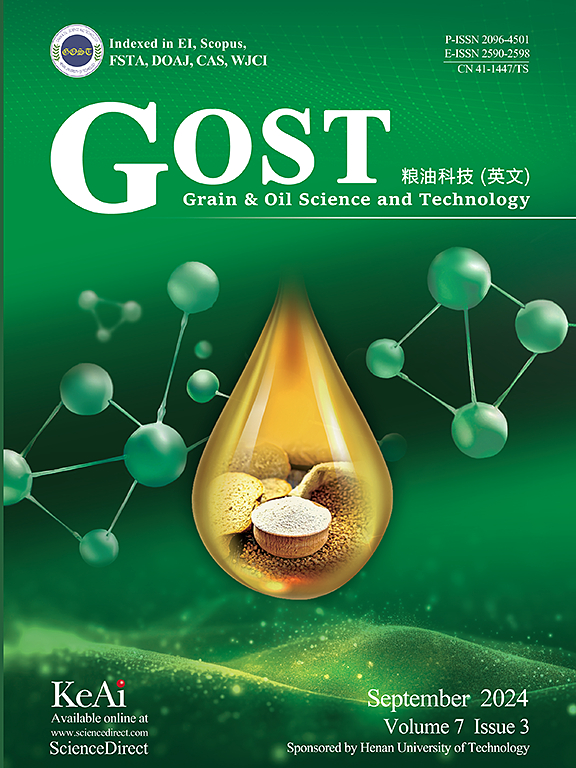Volatile flavor analysis of flesh oil and liver oil from Doederleinia berycoides based on HS-GC-IMS, HS-SPME-GC‐MS and lipidomics
Q2 Agricultural and Biological Sciences
引用次数: 0
Abstract
Edible oils derived from aquatic products are rich in lipids beneficial to human health. However, the volatile flavor characteristics of flesh oil and liver oil from Doederleinia berycoides remain unclear. In this study, flesh oil and liver oil were extracted from Doederleinia berycoides, revealing different fatty acid compositions and contents. Lipidomics analysis identified a total of 124 differential lipids between the flesh oil and liver oil, including 42 glycerophospholipids (GPs), 33 glycerolipids (GLs), 23 free fatty acids (FAs), 13 sphingolipids (SPs), 10 sterols (STs), and 3 prenol lipids (PRs). Analysis using HS-GC-IMS identified 12 key volatile compounds that significantly contributed to the distinct volatile flavors of the flesh and liver oils. The volatile flavors originated from these volatile compounds, which had different Relative Odor Activity Values (ROAVs). Further results from HS-SPME-GC‐MS showed that the volatile flavors of the flesh oil and liver oil were respectively attributed to 64 and 35 volatile compounds, each with unique key volatile compounds exhibiting different ROAVs. There were significant positive or negative correlations between 18 key differential lipids and 24 volatile compounds in both flesh oil and liver oil. Therefore, the complex lipid profiles are responsible for the unique volatile flavors of flesh oil and liver oil, and the differential lipids play a central role in their volatile flavor formation. These findings provide a foundation for understanding the volatile flavor differences in fish oils and hold promise for further exploration of the molecular mechanisms underlying oil volatile flavors.

基于HS-GC-IMS、HS-SPME-GC - MS和脂质组学的黄连肉油和鱼肝油挥发性风味分析
从水产品中提取的食用油富含对人体有益的脂质。然而,目前尚不清楚菟丝子果肉油和鱼肝油的挥发性风味特征。本研究分别从虎斑藤中提取肉油和鱼肝油,揭示了不同脂肪酸的组成和含量。脂质组学分析共鉴定出肉油和肝油之间的124种差异脂质,包括42种甘油磷脂(GPs), 33种甘油脂(GLs), 23种游离脂肪酸(FAs), 13种鞘脂(SPs), 10种甾醇(STs)和3种丙烯醇脂(pr)。利用HS-GC-IMS分析确定了12种主要挥发性化合物,这些化合物对肉和肝油的独特挥发性风味有重要影响。这些挥发性化合物具有不同的相对气味活性值(ROAVs)。进一步的HS-SPME-GC - MS结果表明,肉油和肝油的挥发性风味分别由64种和35种挥发性化合物组成,每种挥发性化合物具有独特的关键挥发性化合物,具有不同的roav。肉油和肝油中18种关键差异脂质与24种挥发性化合物呈显著正相关或负相关。因此,复杂的脂质谱是造成肉油和肝油独特的挥发性风味的原因,而不同的脂质在其挥发性风味的形成中起着核心作用。这些发现为了解鱼油挥发性风味的差异提供了基础,并为进一步探索油脂挥发性风味的分子机制提供了希望。
本文章由计算机程序翻译,如有差异,请以英文原文为准。
求助全文
约1分钟内获得全文
求助全文
来源期刊

Grain Oil Science and Technology
Food Science
CiteScore
7.30
自引率
0.00%
发文量
69
审稿时长
12 weeks
期刊介绍:
 求助内容:
求助内容: 应助结果提醒方式:
应助结果提醒方式:


